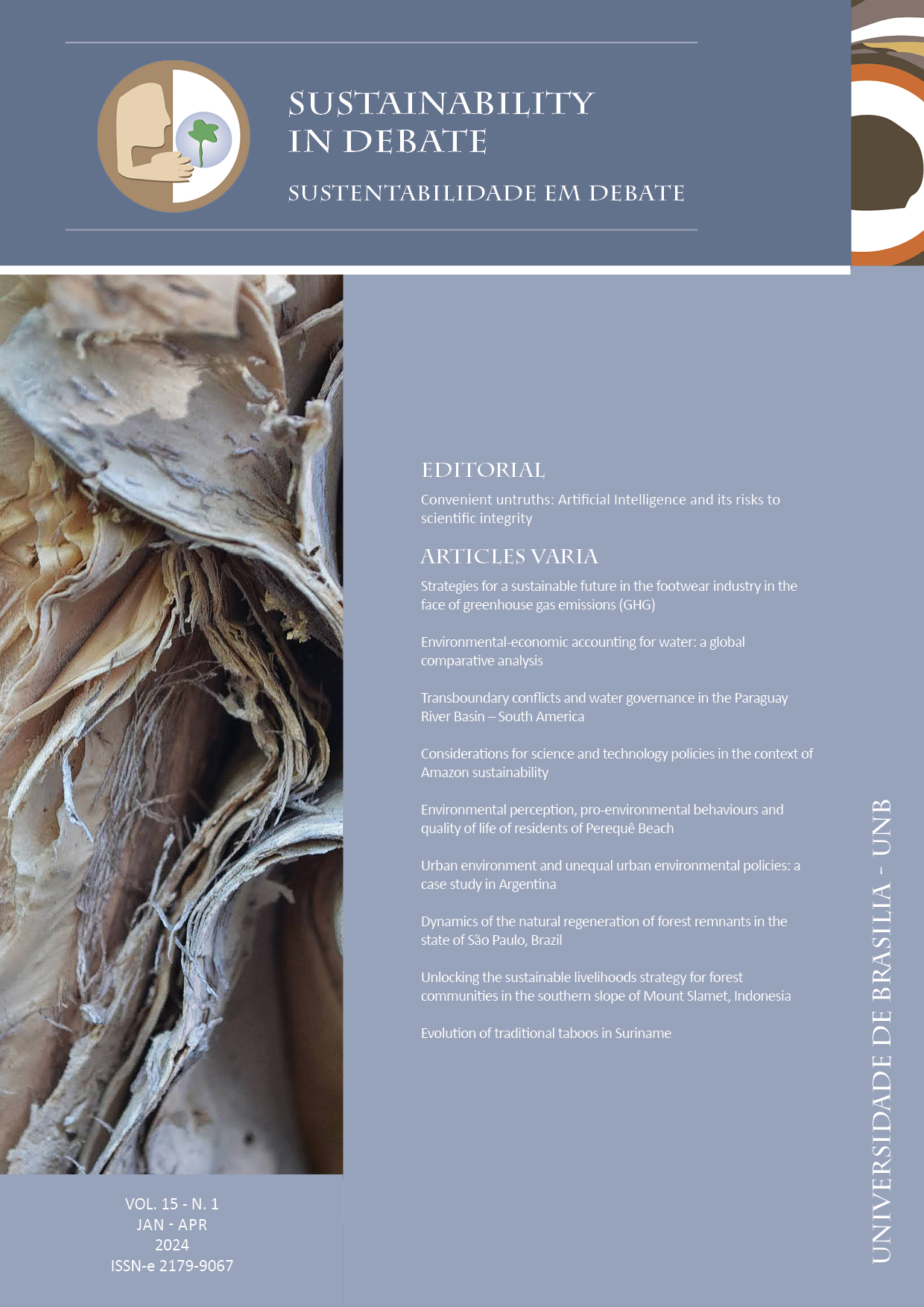Dynamics of the natural regeneration of forest remnants in the state of São Paulo, Brazil
DOI:
https://doi.org/10.18472/SustDeb.v15n1.2024.52288Keywords:
Forest restoration, Geotechnology, Change in land use and coverAbstract
The main factors that favour the regeneration of native vegetation in two regions in southeast Brazil were evaluated over an approximate period of 30 years. Region 1 covers 5.2 million hectares and is situated in the northern and northeastern portions of São Paulo. Region 2, located in eastern São Paulo, is formed by the Paraíba do Sul River basin and spans over 1.4 million hectares. In 2016, the area of native forests in Region 1 accounted for 19.3% of the territory against 16.9% in 1988. In Region 2, forests expanded by 83%, from 250,000 to 455,000 hectares. However, while in Region 1, characterised by competition between agricultural crops, the forest gain was modest, in Region 2, marked by steep terrain and a decline in livestock activities, significant natural forest regeneration was favoured. Restoration of native forest vegetation in the state of São Paulo may vary significantly over regions.
References
BICUDO DA SILVA, R. F.; MORA, N. E.; VIÑA, A.; MILLINGTON, J. D. A.; DOU, Y.; VIEIRA, S. A.; LOPEZ, M. C.; LIU, J. Toward a forest transition across the Brazilian Atlantic Forest biome. Frontiers in Forests and Global Change, v. 6, 2023. DOI: 10.3389/ffgc.2023.1071495.
BRANCALION, P. H. S.; GARCIA, L. C.; LOYOLA, R.; RODRIGUES, R. R.; PILLAR, V. D.; LEWINSOHN, T. M. A critical analysis of the Native Vegetation Protection Law of Brazil (2012): updates and ongoing initiatives. Natureza e Conservação, v. 14, n. S1, p. 141-15, 2016. DOI: 10.1016/j.ncon.2016.03.003.
CALABONI, A.; TAMBOSI, L. R.; IGARI, A. T.; FARINACI, J. S.; METZGER, J. P.; URIARTE, M. The forest transition in São Paulo, Brazil: historical patterns and potential drivers. Ecology and Society, v. 23, n. 4, 2018. DOI: https://doi. org/10.5751/ES-10270-230407.
CROUZEILLES, R.; FERREIRA, M. S.; CHAZDON, R. L.; LINDENMAYER, D. B.; SANSEVERO, J. B.; MONTEIRO, L.; IRIBARREM, A.; LATAWIEC, A. E.; STRASSBURG, B. B. Ecological restoration success is higher for natural regeneration than for active restoration in tropical forests. Science Advances, v. 3, n. 1, e1701345, 2017. DOI: 10.1126/sciadv.1701345.
FERREIRA, M. P.; ALVES, D. S.; SHIMABUKURO, Y. E. Forest dynamics and land-use transitions in the Brazilian Atlantic Forest: the case of sugarcane expansion. Regional Environmental Change, v.15, p. 365–377, 2015. DOI: 10.1007/s10113-014-0652-6.
GIGLIO, E.; LUIZ, A.; NAJBERG, E. As relações sociais como fatores determinantes na rede de implementação de políticas ambientais rurais: investigação a partir de alguns municípios do estado de São Paulo. Revista Desenvolvimento em Questão, v.11, n. 24, p.169-203, 2013. Available in: http://www.redalyc.org/articulo. oa?id=75229296007.
INHAMUNS, M. C.; DE SOUZA REZENDE, R.; COELHO, G. C. Restoring riparian forest in the Atlantic Forest: does planting seedlings make a difference? Restoration Ecology, v. 29, n. 4, e13356, 2021. DOI: https://doi.org/10.1111/ rec.13356.
LEITE, M. S.; SILVA JUNIOR, J. A.; CALABONI, A.; IGARI, A. T. Fatores socioeconômicos e a vegetação nativa em imóveis rurais no estado de São Paulo. Ambiente & Sociedade, v. 23, 2020. DOI: https://doi.org/10.1590/1809- 4422asoc20170309r3vu2020L1AO.
MOLIN, P. G.; GERGEL, E.; SOARES-FILHO, B. S.; FERRAZ, S. F. B. Spatial determinants of Atlantic Forest loss and recovery in Brazil. Landscape Ecology, v. 32, p. 857–870, 2017. DOI: https://doi.org/10.1007/s10980-017-0490-2.
MOLIN, P. G.; CHAZDON, R.; FERRAZ, S. F. B.; BRANCALION, P. H. S. Data from: a landscape approach for optimising the cost-effectiveness of large scale for restrestoration. Zenodo Digital Repository, 2018. DOI: https://doi. org/10.5281/zenodo.1256029.
NALON, M. A.; MATTOS, I. F. A.; FRANCO, G. A. D. C. Inventário da cobertura vegetal nativa do estado de São Paulo. São Paulo, SP: SIMA/IPA. 2022. 238 p. Available in: https://adobeindd.com/view/publications/a5aba10f- 0090-4109-ac1c-944c8260b1ff/57wk/publication-web-resources/pdf/INVENTARIOflorestal_livroFINAL.pdf.
NOVO, A.; JANSEN, K.; SLINGERLAND, M. The sugarcane e biofuel expansion and dairy farmers’ responses in Brazil. Journal of Rural Studies, v. 28, n. 4, p. 640-649. 2012. DOI: https://doi.org/10.1016/j.jrurstud.2012.07.004.
RONQUIM, C. C.; SILVA, R. F. B.; FIGUEIREDO, E. B.; BORDONAL, R. O.; TEIXEIRA, A. H. C.; COCHASRK, T. C. D.; LEIVAS, J. F. Carbon sequestrations sociated to the land-use and land-cover changes in the forestry sector in Southern Brazil. Proceedings of Spie, v. 9998, p. 1-14, 2016.
RONQUIM, C. C.; FONSECA, M. F. Avanço das áreas de cana-de-açúcar e alterações em áreas de agropecuária no interior paulista. Campinas, SP: Embrapa Territorial, 2018. p. 48. (Embrapa Territorial. Documentos, 123).
ROTHER, D. C.; VIDAL, C. Y.; FAGUNDES, I. C.; SILVA, M. M. da.; GANDOLFI, S.; RODRIGUES, R. R.; NAVE, A. G.; VIANI, R. A. G.; BRANCALION, P. H. S. How legal-oriented restoration programs enhance landscape connectivity? Insights from the Brazilian Atlantic Forest. Tropical Conservation Science, v. 11, p. 1-9, jul. 2018. DOI: 10.1177/1940082918785076.
RUDEL, T. K.; COOMES, O. T.; MORAN, E.; ACHARD, F.; ANGELSEN, A.; XU, J.; LAMBIN, E. Forest transitions: towards a global understanding of the land use change. Global Environmental Change, v. 15, n. 1, p. 23-31, 2005. DOI: https://doi.org/10.1016/j.gloenvcha.2004.11.001.
RUDORFF, B. F. T.; AGUIAR, D. A.; SILVA, W. F.; SUGAWARA, L. M.; ADAMI, M.; MOREIRA, M. A. Studies on the rapid expansion of sugarcane for ethanol production in São Paulo State (Brazil) using Landsat Data. Remote Sensing, v. 2, n. 4, p. 1057-1076, 2010. DOI: https://doi.org/10.3390/rs2041057.
SILVA, A. L.; DIOGENES, S. A.; FERREIRA, M. P. Landsat-Based Land Use change assessment in the Brazilian Atlantic Forest: forest transition and sugarcane expansion. Remote Sensing, v. 10, n. 7, 2018. DOI:10.3390/rs10070996.
SILVA, R. F. B.; MILLINGTON, J. D. A.; MORAN, E. F.; BATISTELLA, M.; LIU, J. Three decades of land-use and land- cover change in mountain regions of the Brazilian Atlantic Forest. Landscape and Urban Planning, v. 204, 2020. DOI: https://doi.org/10.1016/j.landurbplan.2020.103948.
SOLÓRZANO, A.; BRASIL, L. S. C. DE A.; DE OLIVEIRA, R. R. The Atlantic Forest Ecologica History: from pre-colonial times to the anthropocene. In: MARQUES, M. C. M.; GRELLE, C. E. V. (ed.). The Atlantic Forest: history, biodiversity, threats and opportunities of the mega-diverse forest. Springer International Publishing, p. 25–44, 2021. DOI: 10.1007/978-3-030-55322-7_2.
SPAROVEK, G.; BARRETTO, A.; BERNDES, G.; MARTINS, S.; MAULE, R. Environmental, land use and economic implications of Brazilian sugarcane expansion 1996–2006. Mitigation Adaptation Strategies Global Change, v. 14, n. 3, p. 285–298. 2009. DOI: 10.1007/s11027-008-9164-3.
VANCINE, M. H.; MUYLAERT, R. L.; NIEBUHR, B. B.; OSHIMA, J. E. F.; TONETTI, V.; BERNARDO, R.; DE ANGELO, C.; ROSA, M. R.; GROHMANN, C. H.; RIBEIRO, M. C. The Atlantic Forest of South America: spatiotemporal dynamics of remaining vegetation and implications for conservation. bioRxiv, 2023. DOI: https://doi. org/10.1101/2023.09.16.558076.
ZANINI, A. M.; MAYRINCK R. C.; VIEIRA, S. A.; CAMARGO, P. B.; RODRIGUES, R. R. The effect of ecological restoration methods on carbon stocks in the Brazilian Atlantic Forest. Forest Ecology and Management, v. 481, 2021. DOI: https://doi.org/10.1016/j.foreco.2020.118734.
Downloads
Published
Issue
Section
License
Copyright (c) 2024 Sustainability in Debate

This work is licensed under a Creative Commons Attribution-NonCommercial-NoDerivatives 4.0 International License.
SUSTAINABILITY IN DEBATE – Copyright Statement
The submission of original scientific work(s) by the authors, as the copyright holders of the text(s) sent to the journal, under the terms of Law 9.610/98, implies in the concession of copyrights of printed and/or digital publication to the Sustainability in Debate Journal of the article(s) approved for publication purposes, in a single issue of the journal. Furthermore, approved scientific work(s) will be released without any charge, or any kind of copyright reimbursement, through the journal’s website, for reading, printing and/or downloading of the text file, from the date of acceptance for publication purposes. Therefore, the authors, when submitting the article (s) to the journal, and gratuitous assignment of copyrights related to the submitted scientific work, are fully aware that they will not be remunerated for the publication of the article(s) in the journal.
The Sustainability in Debate Journal is licensed under Creative Commons License – Non-Commercial-No-Derivation Attribution (Derivative Work Ban) 3.0 Brazil, aiming at dissemination of scientific knowledge, as indicated on the journal's website, which allows the text to be shared, and be recognized in regards to its authorship and original publication in this journal.
Authors are allowed to sign additional contracts separately, for non-exclusive distribution of the works published in the Sustainability in Debate Journal (for example, in a book chapter), provided that it is expressed the texts were originally published in this journal. Authors are allowed and encouraged to publish and distribute their text online, following publication in Sustainability in Debate (e.g. in institutional repositories or their personal pages). The authors expressly agree to the terms of this Copyright Statement, which will be applied following the submission and publishing by this journal.









